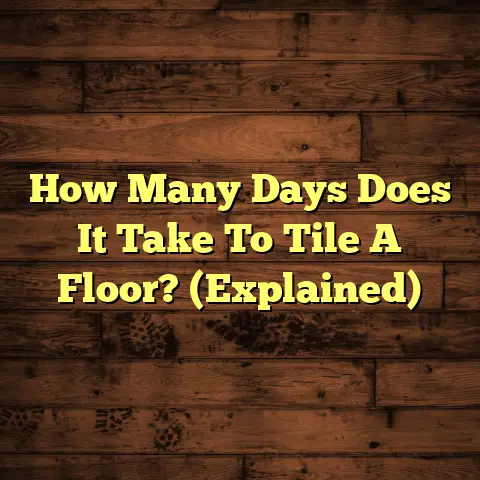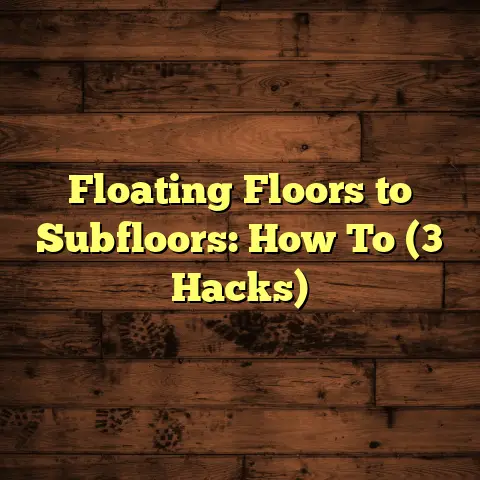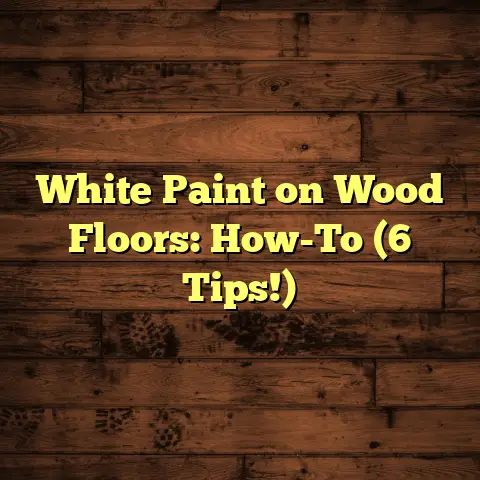Paint Vinyl Like Wood? (4-Step Pro Finish!)
In this article, I’m going to walk you through a four-step process that I’ve personally used to transform dull vinyl into stunning, wood-like surfaces. Get ready to roll up your sleeves and unleash your inner DIY enthusiast!
1. Understanding Vinyl Flooring
Before we dive into painting, let’s chat about vinyl flooring. It’s not all created equal!
Brief Overview of Vinyl Flooring
Vinyl flooring comes in a few main types:
- Sheet Vinyl: This comes in large rolls, offering fewer seams and a water-resistant surface.
- Vinyl Tiles: These are individual squares that you can arrange in various patterns.
- Luxury Vinyl Plank (LVP): Designed to mimic hardwood, LVP is thicker and more durable than traditional vinyl.
- Vinyl Composite Tile (VCT): Commonly used in commercial settings, VCT is known for its durability and affordability.
Vinyl is a popular choice for kitchens, bathrooms, and basements because it’s water-resistant and easy to clean.
Benefits of Vinyl Flooring
Why do people choose vinyl? Here’s the lowdown:
- Durability: Vinyl can withstand a lot of foot traffic and resists scratches and dents.
- Cost-Effectiveness: It’s generally cheaper than hardwood, tile, or stone.
- Maintenance: A quick sweep and mop are usually all you need.
- Water Resistance: Perfect for areas prone to moisture.
Why Homeowners Might Want to Paint Vinyl
So, why paint vinyl if it’s already so great?
- Aesthetic Appeal: Let’s face it, some vinyl patterns are just plain outdated. Painting allows you to update the look without replacing the entire floor.
- Personalization: You can create a custom look that perfectly matches your style.
- Cost Savings: Painting is significantly cheaper than installing new flooring.
- It’s fun! There’s a certain satisfaction in transforming something with your own two hands.
2. Preparation: Setting the Stage for Success
Alright, let’s get down to business. Proper preparation is KEY to a professional-looking finish. Trust me, I’ve seen too many DIY projects fail because this step was skipped.
Step 1: Cleaning the Vinyl Surface
Think of your vinyl floor as a canvas. You wouldn’t paint on a dirty canvas, would you?
- Importance of Thorough Cleaning: Dirt, grease, and grime will prevent the paint from adhering properly, leading to peeling and chipping down the road.
-
Recommended Cleaning Agents and Tools:
- Vacuum: Start by vacuuming the entire floor to remove loose debris.
- Mild Dish Soap and Water: This is a great general cleaner for vinyl.
- Degreaser: For stubborn grease stains, use a dedicated degreaser.
- Scrub Brush or Sponge: Use a soft-bristled brush or sponge to scrub the floor.
- Mop: Finish by mopping the floor with clean water to remove any soap residue.
-
Tips for Ensuring a Clean Surface:
-
Test in an Inconspicuous Area: Before using any cleaning product, test it in a hidden spot to make sure it doesn’t damage the vinyl.
- Rinse Thoroughly: Make sure to remove all traces of cleaning products, as they can interfere with paint adhesion.
- Let it Dry Completely: This is crucial! Paint won’t stick to a damp surface. I usually wait at least 24 hours to be safe.
Step 2: Repairing Imperfections
Scratches, dents, and gouges will show through the paint, so it’s important to address them before you start.
- How to Identify Imperfections: Get down on your hands and knees and really examine the floor. Use a bright light to highlight any imperfections.
-
Recommended Fillers and Products:
- Vinyl Patching Compound: This is specifically designed for repairing vinyl flooring.
- Epoxy Filler: For larger dents or holes, epoxy filler provides a strong and durable repair.
- Latex Caulk: For small cracks or gaps around the edges of the floor.
-
Techniques for Smoothing Out the Surface:
-
Apply the Filler: Follow the manufacturer’s instructions for applying the filler.
- Overfill Slightly: It’s better to overfill slightly, as the filler will shrink as it dries.
- Sand Smooth: Once the filler is dry, use fine-grit sandpaper (220-grit or higher) to sand it smooth and flush with the surrounding floor.
- Clean Again: After sanding, vacuum and wipe down the floor to remove any sanding dust.
3. Choosing the Right Paint
Not all paint is created equal. Using the wrong type of paint can lead to a peeling, chipping mess.
Step 3: Selecting Paint for Vinyl
-
Types of Paint Suitable for Vinyl Flooring:
- 100% Acrylic Latex Paint: This is my go-to choice. It’s durable, water-based, and easy to clean up. Look for paints specifically designed for floors.
- Epoxy Paint: Epoxy paint is extremely durable and resistant to chemicals, but it can be more difficult to apply.
- The Importance of Using Floor Paint vs. Regular Paint: Floor paint is formulated to withstand the wear and tear of foot traffic. Regular paint will likely peel and chip quickly.
-
Recommended Brands and Products:
-
INSL-X Sure Step Acrylic Anti-Slip Coating Paint: A durable, slip-resistant option.
- Rust-Oleum Home Floor Coating: Designed for interior floors, this paint offers good adhesion and durability.
- KILZ Interior/Exterior Enamel Porch and Patio Latex Floor Paint: A versatile option for both indoor and outdoor use.
Pro Tip: Always read the manufacturer’s instructions carefully before using any paint product.
4. Application: The Art of Painting
Now for the fun part! This is where you’ll transform your vinyl floor into a wood-look masterpiece.
Step 4: How to Apply Paint for the Best Results
-
Tools Needed for Application:
- Painter’s Tape: To protect baseboards and other surfaces.
- Primer (Optional but Recommended): A good primer will help the paint adhere better and provide a more uniform finish.
- Paint Tray: To hold the paint.
- Paint Brush: For cutting in around the edges of the room.
- Roller: Use a low-nap roller for a smooth finish.
- Sea Sponge: To create wood grain patterns.
- Rag: To wipe away excess paint.
-
Techniques for Applying Paint Evenly and Avoiding Streaks:
-
Start with a Primer (if using): Apply a thin, even coat of primer and let it dry completely.
- Cut In Around the Edges: Use a brush to paint a 2-3 inch strip around the perimeter of the room.
- Roll the Paint: Dip the roller into the paint tray, making sure to saturate the roller evenly. Roll the paint onto the floor in long, even strokes, overlapping each stroke slightly.
- Apply Thin Coats: It’s better to apply two thin coats than one thick coat. Thick coats are more likely to drip and run.
- Let Each Coat Dry Completely: Follow the manufacturer’s instructions for drying time.
-
Tips for Achieving a Wood-Like Finish:
-
Base Coat: Apply a base coat of a light brown or beige color. This will be your “wood” color.
- Wood Grain Effect: Once the base coat is dry, use a sea sponge to apply a darker brown or gray glaze. Drag the sponge across the floor in long, irregular strokes to mimic wood grain.
- Layering: Experiment with different colors and techniques to create a more realistic wood look. You can use a rag to wipe away some of the glaze, revealing the base coat underneath.
- Color Choices: Consider the type of wood you want to mimic. For a light wood look, use light brown and beige tones. For a darker wood look, use darker browns and grays.
- Consider using a Wood Graining Tool: There are tools available that help you achieve a realistic wood grain effect.
Pro Tip: Practice your wood grain technique on a piece of cardboard before you start painting your floor.
5. Finishing Touches: Sealing and Protecting Your Work
You’ve put in the hard work, now it’s time to protect your investment. Sealing the painted surface is crucial for durability and longevity.
- Importance of Sealing the Painted Surface: A sealant will protect the paint from scratches, stains, and wear and tear.
-
Recommended Sealants and Their Application:
- Water-Based Polyurethane: This is a great choice for painted vinyl floors. It’s durable, easy to apply, and dries to a clear finish.
- Application: Apply two to three coats of polyurethane, following the manufacturer’s instructions. Use a clean roller or brush to apply the sealant in thin, even coats. Let each coat dry completely before applying the next.
-
Tips for Maintenance and Care Post-Painting:
-
Wait Before Heavy Traffic: Allow the sealant to cure completely before walking on the floor or placing furniture on it. I recommend waiting at least 72 hours.
- Use Area Rugs: Place area rugs in high-traffic areas to protect the floor from wear and tear.
- Clean Regularly: Sweep or vacuum the floor regularly to remove dirt and debris.
- Mop with a Mild Cleaner: Use a mild cleaner specifically designed for vinyl floors. Avoid using harsh chemicals or abrasive cleaners.
- Avoid Scuffing: Use felt pads under furniture legs to prevent scuffing.
6. Real-Life Transformations: Before and After
Let’s get inspired! Here are some examples of successful vinyl to wood transformations I’ve seen:
Case Studies of Successful Vinyl to Wood Transformations
- The Dated Kitchen: One client had a kitchen with outdated, yellowed vinyl flooring. We cleaned the floor, applied a base coat of light beige paint, and then used a wood graining tool to create a realistic oak look. The transformation was incredible!
- The Basement Makeover: Another client wanted to update their basement without spending a fortune. We painted the existing vinyl floor with a dark brown base coat and then used a sea sponge to create a walnut wood grain effect. The result was a warm and inviting space.
- The Rental Refresh: I once helped a landlord update a rental property by painting the old vinyl flooring to look like wood. This simple update made the property much more appealing to potential tenants.
Visuals: Before and After Photos of Painted Vinyl Flooring
(Imagine here a series of before and after photos showcasing the transformations described above)
Testimonials from Homeowners Who Have Completed the Process
- “I couldn’t believe how easy it was to paint my vinyl floor! It completely transformed my kitchen and saved me a ton of money.” – Sarah M.
- “I was hesitant to try painting my vinyl floor, but I’m so glad I did! It looks amazing and I get compliments on it all the time.” – John B.
- “This was the perfect solution for updating my rental property on a budget. The painted vinyl floor looks great and is easy to maintain.” – Lisa K.
7. Conclusion: The Benefits of Painted Vinyl
You’ve made it to the end! Let’s recap what we’ve learned.
Recap of the Four Steps
- Preparation: Clean and repair the vinyl surface.
- Choosing the Right Paint: Select a high-quality floor paint.
- Application: Apply the paint using proper techniques.
- Finishing Touches: Seal the painted surface for protection.
The Long-Term Benefits of Painting Vinyl Like Wood
- Cost Savings: Save money on new flooring.
- Aesthetic Appeal: Update the look of your home.
- Personalization: Create a custom look that reflects your style.
- Increased Home Value: A well-done painting project can increase the value of your home.
Encouragement for Readers to Take on the Project Themselves
Painting your vinyl floor to look like wood is a rewarding DIY project that can transform your space without breaking the bank. With a little preparation, the right tools, and a bit of creativity, you can achieve a professional-looking finish that you’ll be proud of.
So, what are you waiting for? Grab your paint brushes and get started! I’m confident that you can create a beautiful and unique wood-look floor that will enhance your home for years to come. Good luck, and happy painting!





